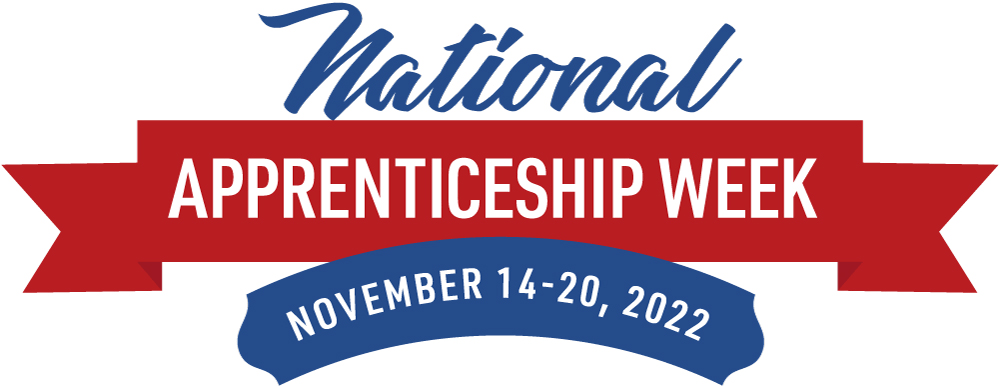From Apprenticeship, Good Things Come

National Association of Workforce Boards
National Apprenticeship Week (NAW) is a celebration observed nationwide. Established by the U.S. Department of Labor (DOL), it brings workforce stakeholders together to educate the public on the potential of apprenticeships and recognize the successes they produce.
At NAWB, we eagerly await this week. Over the years, NAWB has been engaged in multiple grants with DOL around registered apprenticeship programs, including the Supply Chain Automation Workforce Hub, an ongoing project which is supporting crucial supply chain talent development. We invest in apprenticeship because it’s a unique, powerful strategy– one of the most important tactics at the workforce system’s disposal. When employers, educators, labor, and communities embrace apprenticeship, good things come.
Why Apprenticeship?
The heart of work-based learning–– purposeful embrace of the ongoing education and growth that is part of every job– is what makes it such an impactful and critically important strategy. Work-based learning allows for a set of possibilities that conventional skills training doesn’t. In turn, apprenticeships are the exemplar among work-based learning approaches, and the gold-star tool in the workforce development toolkit.
What’s in apprenticeship for workers? A DOL-approved registered apprenticeship means a job, and a paycheck, from day one. It guarantees a quality education, an industry-standard credential, and an in-demand skillset, most often in a fast-growing and high-paying field. A registered apprenticeship is the rare career pathway that invests in you– not just the other way around. These programs aren’t just the best of the best from a skills perspective; they allow career seekers to avoid the debt burdens which quality education and training so often demand. An apprenticeship means a livable job from the beginning.
For employers, the benefits are equally significant. When a business or a regional industry faces a talent deficit, apprenticeship is the strongest strategy to develop a highly skilled talent pipeline. Apprenticeships improve recruiting, retention, and productivity: in sum, profitability. Employers can even receive tax credits when they work with partners to develop a program and begin employing apprentices.
It all adds up to a win-win-win: for workers, employers, and communities. 92% of apprentices are retained by their employer after completing an apprenticeship program: that means enormous savings on recruitment for employers and a clear, reliable career pathway for workers. And workers leave apprenticeship programs poised to earn family sustaining wages: the average starting wage after completing an apprenticeship program is $72,000. Workers who complete apprenticeship programs earn an average of $300,000 more over their careers compared to peers who don’t.
All in all, the answer to the question “why apprenticeship?” is: it works.
Apprenticeship and Workforce Boards
Where does the workforce development board figure into this equation? The broadest answer is, where it always does: at the center of it all, a place no other entity occupies. The workforce development board inhabits a special position which allows it to identify labor market trends– and needs– before they are broadly felt in a region. Workforce development boards are the essential intermediary that brings key stakeholders together to forge collaborations which drive community development and economic growth, and this remains true in the context of apprenticeship.
Successful apprenticeships are born from collaboration among partners – businesses, workforce intermediaries, educational institutions, and other key community organizations. Partners work together to identify necessary resources, design the apprenticeship program, and recruit and support apprentices.
There are a wide range of support functions that a workforce development board can perform. They may support the employer by helping to write job descriptions, train apprentice supervisors, or research and formalize teaching best practices. They may spread awareness about an apprenticeship, and play an important role in educating stakeholders who are unfamiliar with Registered Apprenticeship or needlessly intimidated by the prospect. They can handle a portion of administrative work, offer subject-specific technical assistance, and observe and mentor apprentices. This isn’t a comprehensive list– the options are, truly, unlimited.
It’s also worth noting that a workforce board or one of its partners can sponsor an apprenticeship– in other words: register it, develop formal agreements with apprentices, and assume full responsibility for operating the program and meeting all relevant regulatory requirements. This obligation is by no means a solo enterprise: all Registered Apprenticeship Programs rely on a partnership between one or more sponsors, employers, education providers, and supportive service providers.
The Gold-Star Tool
The power of apprenticeships and work-based learning as a whole is palpable. You don’t have to be a workforce professional to know that there’s really no substitute for the education a job itself provides you. Learning on the job isn’t always possible (or wise), but when it is, it’s the gold-standard. It’s the best way to learn and the most effective way to teach. This is what we mean when we call apprenticeship “the gold star tool.”
Everyone benefits from apprenticeship. Employers and industries profit; workers earn and learn; communities develop and prosper. Right now, Registered Apprenticeships are providing 600,000 American workers with an exceptional education and a steady income at the same time, positioning them to go on to long, rewarding, well paid careers. That’s remarkable.
Our only complaint is that this number isn’t enough. Happily, it continues to grow. This year’s National Apprenticeship Week has impressed on us that appreciation of apprenticeship is spreading too.


National Association of Workforce Boards | All Rights Reserved |
Created by Olive + Ash.
Managed by Olive Street Design.





